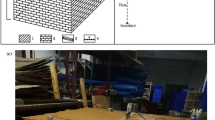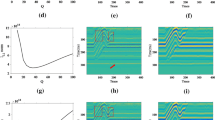Abstract
The electric inversion technique reconstructs the subsurface medium distribution from acquired data. On the basis of electric inversion, objects buried under the earth or seabed, such as pipelines and unexploded ordnance, are detected and located in a contactless manner. However, the process of accurately reconstructing the shape of the target object is challenging because electric inversion is a nonlinear and ill-posed problem. In this work, we present an inverse multiquadric (IMQ) regularization method based on the level set function for reconstructing buried pipelines. In the case of locating underwater objects, the unknown inversion area is split into two parts, the background and the pipeline with known conductivity. The geometry of the pipeline is represented based on the level set function for achieving a noiseless inversion image. To obtain a binary image, the IMQ is used as the regularization term, which ‘pushes’ the level set function away from 0. We also provide an appropriate method to select the bandwidth and regularization parameters for the IMQ regularization term, resulting in reconstructed images with sharp edges. The simulation results and analysis show that the proposed method performs better than classical inversion methods.
Similar content being viewed by others
References
Adler, A., and Lionheart, W. R., 2006. Uses and abuses of eidors: An extensible software base for EIT. Physiological Measurement, 27: S25.
Aghasi, A., Kilmer, M., and Miller, E. L., 2011. Parametric level set methods for inverse problems. SIAM Journal on Imaging Sciences, 4: 618–650.
Ammari, H., Garnier, J., and Sølna, K., 2013. Resolution and stability analysis in full-aperture, linearized conductivity and wave imaging. Proceedings of the American Mathematical Society, 141: 3431–3446.
Batenburg, K. J., and Sijbers, J., 2011. Dart: A practical reconstruction algorithm for discrete tomography. IEEE Transactions on Image Processing, 20: 2542–2553.
Bazeille, S., Lebastard, V., Lanneau, S., and Boyer, F., 2017. Model based object localization and shape estimation using electric sense on underwater robots. IFAC—PapersOnLine, 50(1): 5047–5054.
Borsic, A., and Adler, A., 2012. A primal-dual interior-point framework for using the L1 or L2 norm on the data and regularization terms of inverse problems. Inverse Problems, 28: 095011.
Borsic, A., Lionheart, W. R., and McLeod, C. N., 2002. Generation of anisotropic-smoothness regularization filters for EIT. IEEE Transactions on Medical Imaging, 21: 579–587.
Brown, B. H., 2003. Electrical impedance tomography (EIT): A review. Journal of Medical Engineering and Technology, 27: 97–108.
Chambolle, A., and Pock, T., 2011. A first-order primal-dual algorithm for convex problems with applications to imaging. Journal of Mathematical Imaging and Vision, 40: 120–145.
Chen, S., Wu, J., Huang, X., and Li, J., 2019. An accurate localization method for subsea pipelines by using external magnetic fields. Measurement, 147: 106803.
Constable, S. C., Parker, R. L., and Constable, C. G., 1987. Occam’s inversion: A practical algorithm for generating smooth models from electromagnetic sounding data. Geophysics, 52: 289–300.
Fournier, D., and Oldenburg, D. W., 2019. Inversion using spatially variable mixed ℓp norms. Geophysical Journal International, 218(1): 268–282.
Halter, R. J., Schned, A., Heaney, J., Hartov, A., Schutz, S., and Paulsen, K. D., 2008. Electrical impedance spectroscopy of benign and malignant prostatic tissues. The Journal of Urology, 179: 1580–1586.
Hu, M., Yu, P., Rao, C., Zhao, C., and Zhang, L., 2019. 3D sharp-boundary inversion of potential-field data with an adjustable exponential stabilizing functional. Geophysics, 84: J1–J15.
Hua, P., Woo, E. J., Webster, J. G., and Tompkins, W. J., 1991. Iterative reconstruction methods using regularization and optimal current patterns in electrical impedance tomography. IEEE Transactions on Medical Imaging, 10: 621–628.
Huang, X., Chen, G., Zhang, Y., Li, J., Xu, T., and Chen, S., 2018. Inversion of magnetic fields inside pipelines: Modeling, validations, and applications. Structural Health Monitoring, 17: 80–90.
Huang, X., Chen, S., Guo, S., Zhao, W., and Jin, S., 2013. Magnetic charge and magnetic field distributions in ferromagnetic pipe. Applied Computational Electromagnetics Society Journal, 28: 737–746.
Jafarpour, S., Xu, W., Hassibi, B., and Calderbank, R., 2009. Efficient and robust compressed sensing using optimized expander graphs. IEEE Transactions on Information Theory, 55: 4299–4308.
Jin, H., Guo, J., Wang, H., Zhuang, Z., Qin, J., and Wang, T., 2020. Magnetic anomaly detection and localization using orthogonal basis of magnetic tensor contraction. IEEE Transactions on Geoscience and Remote Sensing, 58: 5944–5954.
Jung, Y. M., and Yun, S., 2014. Impedance imaging with firstorder TV regularization. IEEE Transactions on Medical Imaging, 34: 193–202.
Kadu, A., van Leeuwen, T., and Batenburg, K. J., 2017. A parametric level-set method for partially discrete tomography. In: Discrete Geometry for Computer Imagery. DGCI 2017. Kropatsch, W., et al., eds., Springer, Cham, 122–134.
Kadu, A., van Leeuwen, T., and Mulder, W. A., 2016. Salt reconstruction in full-waveform inversion with a parametric levelset method. IEEE Transactions on Computational Imaging, 3: 305–315.
Liu, D., Khambampati, A. K., and Du, J., 2017. A parametric level set method for electrical impedance tomography. IEEE Transactions on Medical Imaging, 37: 451–460.
Liu, D., Khambampati, A. K., Kim, S., and Kim, K. Y, 2015. Multi-phase flow monitoring with electrical impedance tomography using level set based method. Nuclear Engineering and Design, 289: 108–116.
Martins, J., Moura, C., and Vargas, R., 2018. Image reconstruction using simulated annealing in electrical impedance tomography: A new approach. Inverse Problems in Science and Engineering, 26: 834–854.
Miller, L. M., Silverman, Y., MacIver, M. A., and Murphey, T. D., 2015. Ergodic exploration of distributed information. IEEE Transactions on Robotics, 32: 36–52.
Pidlisecky, A., Haber, E., and Knight, R., 2007. Resinvm3D: A 3D resistivity inversion package. Geophysics, 72: H1–H10.
Portniaguine, O., and Zhdanov, M. S., 1999. Focusing geophysical inversion images. Geophysics, 64: 874–887.
Ranjan, S., Kambhammettu, B., Peddinti, S. R., and Adinarayana, J., 2018. A compressed sensing based 3D resistivity inversion algorithm for hydrogeological applications. Journal of Applied Geophysics, 151: 318–327.
Renaut, R. A., Vatankhah, S., and Ardestani, V. E., 2017. Hybrid and iteratively reweighted regularization by unbiased predictive risk and weighted GCV for projected systems. SIAM Journal on Scientific Computing, 39: B221–B243.
Sadleir, R. J., and Fox, R. A., 2001. Detection and quantification of intraperitoneal fluid using electrical impedance tomography. IEEE Transactions on Biomedical Engineering, 48: 484–491.
Shang, W., Xue, W., Li, Y., and Xu, Y., 2020. Improved primaldual interior-point method using the lawson-norm for inverse problems. IEEE Access, 8: 41053–41061.
Shang, W., Xue, W., Xu, Y., and Geng, W., 2019. Undersea target reconstruction based on coupled laplacian-of-gaussian and minimum gradient support regularizations. IEEE Access, 7: 171633–171647.
Shi, W., Li, Y., and Wang, Y., 2019. Noise-free maximum correntropy criterion algorithm in non-gaussian environment. IEEE Transactions on Circuits and Systems II: Express Briefs, 67: 2224–2228.
Simyrdanis, K., Moffat, I., Papadopoulos, N., Kowlessar, J., and Bailey, M., 2018. 3D mapping of the submerged Crowie barge using electrical resistivity tomography. International Journal of Geophysics, 2018: 6480565.
Soleimani, M., Lionheart, W., and Dorn, O., 2006. Level set reconstruction of conductivity and permittivity from boundary electrical measurements using experimental data. Inverse Problems in Science and Engineering, 14: 193–210.
Sun, B., Yue, S., Cui, Z., and Wang, H., 2015. A new linear back projection algorithm to electrical tomography based on measuring data decomposition. Measurement Science and Technology, 26: 125402.
Sun, B., Yue, S., Hao, Z., Cui, Z., and Wang, H., 2019. An improved tikhonov regularization method for lung cancer monitoring using electrical impedance tomography. IEEE Sensors Journal, 19: 3049–3057.
Tehrani, J. N., McEwan, A., Jin, C., and Van Schaik, A., 2012. L1 regularization method in electrical impedance tomography by using the L1-curve (Pareto frontier curve). Applied Mathematical Modelling, 36: 1095–1105.
Tian, W., 2008. Integrated method for the detection and location of underwater pipelines. Applied Acoustics, 69: 387–398.
Utsugi, M., 2019. 3-D inversion of magnetic data based on the L1–L2 norm regularization. Earth, Planets and Space, 71: 73.
Vo, C. K., Staples, S., Cowell, D. M., Varcoe, B., and Freear, S., 2020. Determining the depth and location of buried pipeline by magnetometer survey. Journal of Pipeline Systems Engineering and Practice, 11: 04020001.
Wolf-Homeyer, S., 2019. Object localization in fluids based on a bioinspired electroreceptor system. PhD thesis. Bielefeld University Germany.
Wu, P., and Guo, Z., 2020. High-precision inversion of buried depth inurban underground iron pipelines based on AM-PSO algorithmfor magnetic anomaly. Progress in Electromagnetics Research, 100: 17–30.
Xiang, Y., Yu, P., Zhang, L., Feng, S., and Utada, H., 2017. Regularized magnetotelluric inversion based on a minimum support gradient stabilizing functional. Earth, Planets and Space, 69: 158.
Zhdanov, M. S., and Portniaguine, O., 1999. Focusing geophysical inversion images. Geophysics, 64: 874–887.
Acknowledgements
This work was supported by the National Natural Science Foundation of China (No. 52101383), the Fundamental Research Funds for the Central Universities (No. 307 2021CF0802), the Key Laboratory of Advanced Marine Communication and Information Technology, Ministry of Industry and Information Technology (No. AMCIT2101-02), the Sino-Russian Cooperation Fund of Harbin Engineering University (No. 2021HEUCRF006), the Ministry of Science and Higher Education of the Russian Federation (No. 075-15-2020-934), and the International Science & Technology Cooperation Program of China (No. 2014DF R10240).
Author information
Authors and Affiliations
Corresponding author
Rights and permissions
About this article
Cite this article
Shang, W., Xue, W., Xu, Y. et al. Undersea Buried Pipeline Reconstruction Based on the Level Set and Inverse Multiquadric Regularization Method. J. Ocean Univ. China 21, 101–112 (2022). https://doi.org/10.1007/s11802-022-4837-1
Received:
Revised:
Accepted:
Published:
Issue Date:
DOI: https://doi.org/10.1007/s11802-022-4837-1




